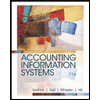
FUND.ACCT.PRIN.-CONNECT ACCESS
25th Edition
ISBN: 9781260780185
Author: Wild
Publisher: MCG
expand_more
expand_more
format_list_bulleted
Textbook Question
Chapter 17, Problem 16E
Exercise 17-16 Interpreting financial ratios A1 P3 Refer to the information in Exercise 17-15.
1. Which company has the better (a) profit margin, (b) asset turnover, and (c) return on assets?
2. Which company has the better rate of growth in sales?
3. Did Roak successfully use financial leverage in the current year? Did Clay?
Expert Solution & Answer
Want to see the full answer?
Check out a sample textbook solution
Students have asked these similar questions
I need help finding the accurate solution to this financial accounting problem with valid methods.
What is the cost of goods sold for yaghan enterprises?
Please provide the solution to this general accounting question using proper accounting principles.
Chapter 17 Solutions
FUND.ACCT.PRIN.-CONNECT ACCESS
Ch. 17 - Prob. 1QSCh. 17 - QS 17-2 Standard of comparison C2
Identify which...Ch. 17 - Prob. 3QSCh. 17 - Trend percents P1 Use the following information to...Ch. 17 - QS17-5 Common-size analysis P2
Refer to the...Ch. 17 - QS 17-6 Computing current ratio and acid-test...Ch. 17 - QS 17-7 Computing accounts receivable turnover and...Ch. 17 - QS 17-8 Computing inventory turnover and days'...Ch. 17 - QS17-9 Computing total asset turnover P3
Dundee...Ch. 17 - Prob. 10QS
Ch. 17 - Prob. 11QSCh. 17 - QS 17-12 Computing price-earnings ratio and...Ch. 17 - Prob. 13QSCh. 17 - Prob. 14QSCh. 17 - QS 17-15A Identifying unusual and/or infrequent...Ch. 17 - Prob. 16QSCh. 17 - Prob. 17QSCh. 17 - Prob. 18QSCh. 17 - Prob. 19QSCh. 17 - Prob. 20QSCh. 17 - Prob. 21QSCh. 17 - Prob. 22QSCh. 17 - Exercise 17-1
Building blocks of analysis
Match...Ch. 17 - Prob. 2ECh. 17 - Prob. 3ECh. 17 - Prob. 4ECh. 17 - Prob. 5ECh. 17 - Prob. 6ECh. 17 - Prob. 7ECh. 17 - Prob. 8ECh. 17 - Prob. 9ECh. 17 - Prob. 10ECh. 17 - Exercise 17-11 Analyzing profitability P3 Q Refer...Ch. 17 - Prob. 12ECh. 17 - Prob. 13ECh. 17 - Prob. 14ECh. 17 - Prob. 15ECh. 17 - Exercise 17-16 Interpreting financial ratios A1 P3...Ch. 17 - Prob. 17ECh. 17 - Prob. 18ECh. 17 - Problem 17-1A Calculating and analyzing trend...Ch. 17 - Problem 17-2A Ratios, common-size statements, and...Ch. 17 - Problem 17-3A
Transactions, working capital, and...Ch. 17 - Problem 17-4A Calculating financial statement...Ch. 17 - Prob. 5PSACh. 17 - Prob. 6PSACh. 17 - Prob. 1PSBCh. 17 - Prob. 2PSBCh. 17 - Prob. 3PSBCh. 17 - Prob. 4PSBCh. 17 - Prob. 5PSBCh. 17 - Prob. 6PSBCh. 17 - SP 17 Use the following selected data from...Ch. 17 - Prob. 1AACh. 17 - Prob. 2AACh. 17 - Prob. 3AACh. 17 - Prob. 1DQCh. 17 - Prob. 2DQCh. 17 - Prob. 3DQCh. 17 - 4. What three factors would influence your...Ch. 17 - Prob. 5DQCh. 17 - Prob. 6DQCh. 17 - Prob. 7DQCh. 17 - Prob. 8DQCh. 17 - Prob. 9DQCh. 17 - Prob. 10DQCh. 17 - What ratios would you compute to evaluate...Ch. 17 - Why would a company’s return on total assets be...Ch. 17 - 13. Where on the income statement does a company...Ch. 17 - BTN 17-1 Refer to Apple’s financial statements in...Ch. 17 - Prob. 2BTNCh. 17 - Prob. 3BTNCh. 17 - Prob. 4BTNCh. 17 - Prob. 5BTN
Knowledge Booster
Learn more about
Need a deep-dive on the concept behind this application? Look no further. Learn more about this topic, accounting and related others by exploring similar questions and additional content below.Similar questions
- I am searching for the correct answer to this general accounting problem with proper accounting rules.arrow_forwardI am looking for the correct answer to this financial accounting problem using valid accounting standards.arrow_forwardPlease provide the correct answer to this financial accounting problem using valid calculations.arrow_forward
- Can you solve this general accounting question with the appropriate accounting analysis techniques?arrow_forwardSiemens Technology produces ergonomic keyboards for $75.00 per unit. The variable cost per unit is $27.00. Each keyboard requires 4 direct labor hours and 6 machine hours to produce. Which of the following is the correct contribution margin per machine hour? a) $8.00 b) $12.00 c) $19.00 d) $48.00 e) None of these.arrow_forwardI need assistance with this general accounting question using appropriate principles.arrow_forward
- Please provide the correct answer to this general accounting problem using accurate calculations.arrow_forwardI need help finding the accurate solution to this general accounting problem with valid methods.arrow_forwardPlease provide the solution to this general accounting question with accurate financial calculations.arrow_forward
arrow_back_ios
SEE MORE QUESTIONS
arrow_forward_ios
Recommended textbooks for you
 Managerial AccountingAccountingISBN:9781337912020Author:Carl Warren, Ph.d. Cma William B. TaylerPublisher:South-Western College Pub
Managerial AccountingAccountingISBN:9781337912020Author:Carl Warren, Ph.d. Cma William B. TaylerPublisher:South-Western College Pub Cornerstones of Financial AccountingAccountingISBN:9781337690881Author:Jay Rich, Jeff JonesPublisher:Cengage Learning
Cornerstones of Financial AccountingAccountingISBN:9781337690881Author:Jay Rich, Jeff JonesPublisher:Cengage Learning Financial Accounting: The Impact on Decision Make...AccountingISBN:9781305654174Author:Gary A. Porter, Curtis L. NortonPublisher:Cengage Learning
Financial Accounting: The Impact on Decision Make...AccountingISBN:9781305654174Author:Gary A. Porter, Curtis L. NortonPublisher:Cengage Learning Accounting Information SystemsFinanceISBN:9781337552127Author:Ulric J. Gelinas, Richard B. Dull, Patrick Wheeler, Mary Callahan HillPublisher:Cengage Learning
Accounting Information SystemsFinanceISBN:9781337552127Author:Ulric J. Gelinas, Richard B. Dull, Patrick Wheeler, Mary Callahan HillPublisher:Cengage Learning

Managerial Accounting
Accounting
ISBN:9781337912020
Author:Carl Warren, Ph.d. Cma William B. Tayler
Publisher:South-Western College Pub

Cornerstones of Financial Accounting
Accounting
ISBN:9781337690881
Author:Jay Rich, Jeff Jones
Publisher:Cengage Learning

Financial Accounting: The Impact on Decision Make...
Accounting
ISBN:9781305654174
Author:Gary A. Porter, Curtis L. Norton
Publisher:Cengage Learning



Accounting Information Systems
Finance
ISBN:9781337552127
Author:Ulric J. Gelinas, Richard B. Dull, Patrick Wheeler, Mary Callahan Hill
Publisher:Cengage Learning
Financial ratio analysis; Author: The Finance Storyteller;https://www.youtube.com/watch?v=MTq7HuvoGck;License: Standard Youtube License